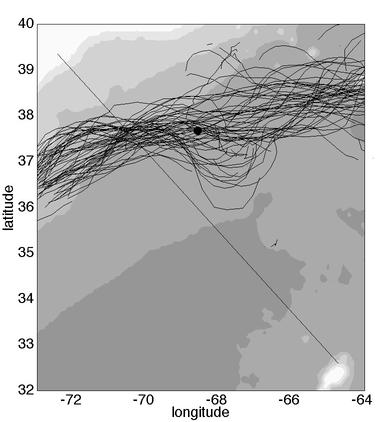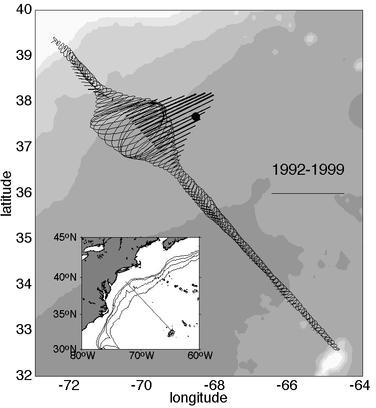|
A convenient method to get a good measure of the meandering is to
examine the trajectories of subsurface floats in the Gulf Stream.
|
-
Various paths of the Gulf Stream inferred from the
trajectories of 68 isopycnal RAFOS floats drifting on/near the 26.8
sigma-t surface (Song et al., 1995).
-
There is a clear convergence of
paths as they approach the Oleander line and the pattern of sharp
spreading farther east.
-
The ship crosses the current virtually where the path crossings have least
spread!
-
This convergence of paths reflects the closing of the meander envelope. We
think this is the cause of the apparent conversion of momentum and
heat back into the mean flow.
-
Farther to the east, at the
black dot, observations show just the opposite, a strong conversion
from the mean flow into the eddy field (Johns et al., 1995).
-
Clearly these processes can be quite site-specific.
|

|
|
|
Figure 14. Paths of the Gulf Stream (15°C at 380 m) constructed from
68 isopycnal RAFOS floats on the 26.8 sigma-t-surface. The line indicates
the path of the Oleander route.
We
compute the location where the sloping 15° C (sigma-t = 26.8) surface
intersects 380 m (close to the velocity maximum on this surface)
using the hyperbolic tangent function:
y(Z15) = -40tanh((Z15-380)/300).
Given a float's depth, geographical position, direction of motion, we
know where it is on this surface and therefore can estimate the
normal distance to and hence the position of the intersection of 26.8
sigma-t and 380 m depth.
|




 Eddy Exchange Processes >>
Discussion and Conclusions
Eddy Exchange Processes >>
Discussion and Conclusions
